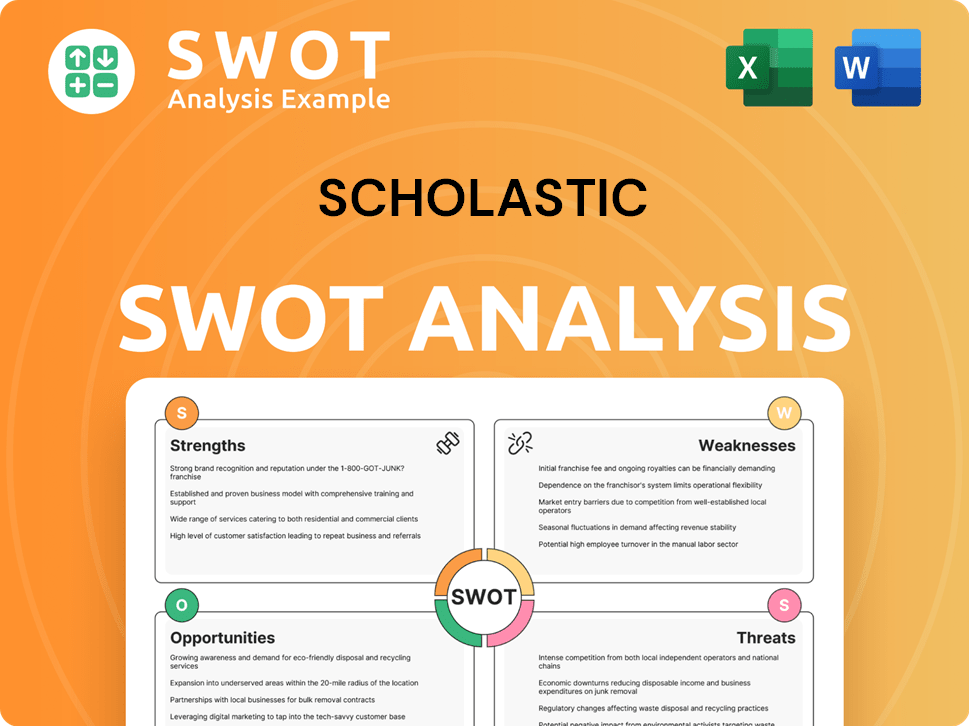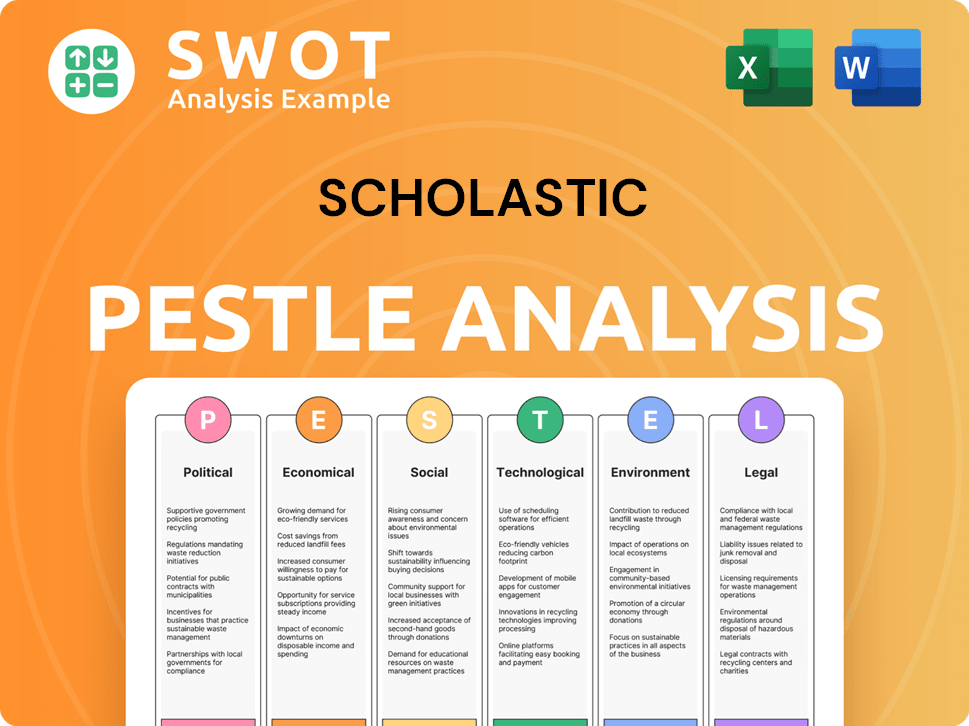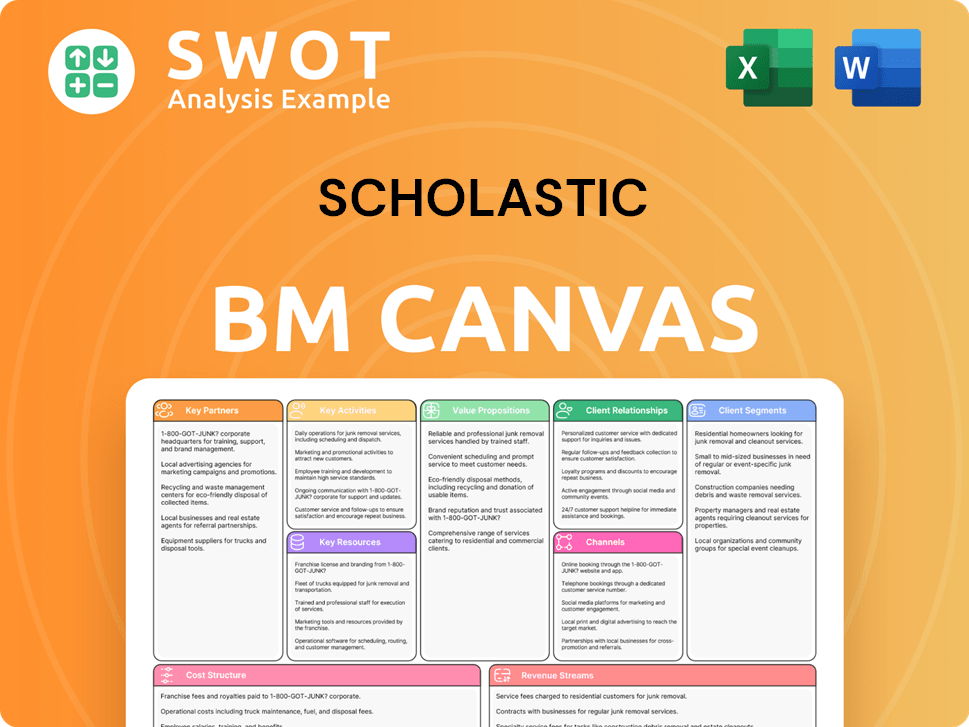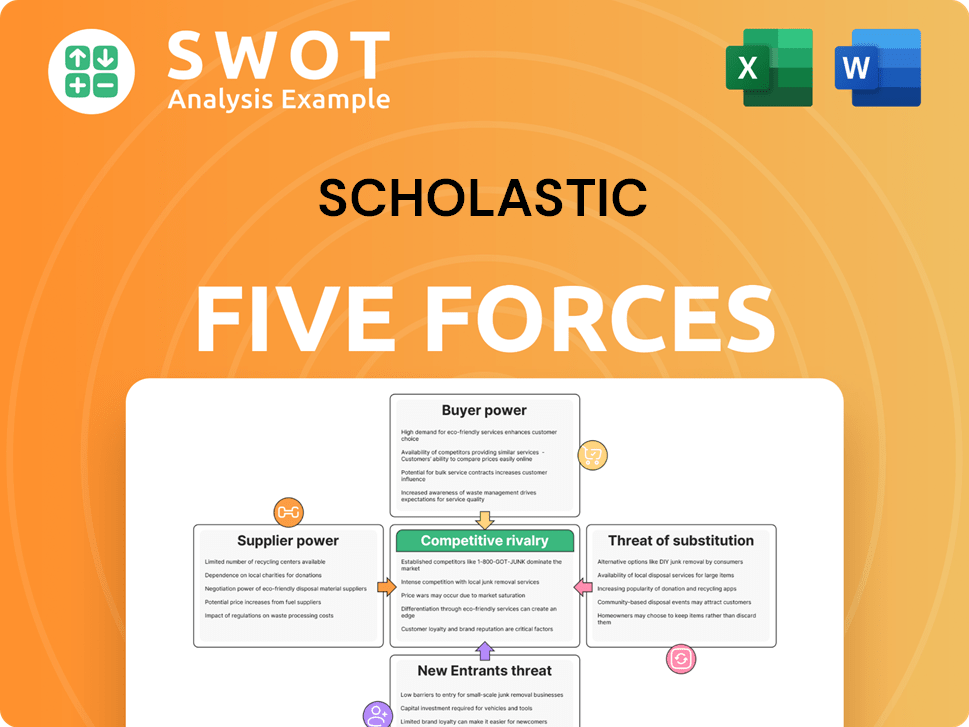Scholastic Bundle
How Does Scholastic Stay Ahead in the Children's Publishing World?
Scholastic Corporation, a titan in children's publishing, consistently captures young readers' imaginations, as evidenced by the enduring success of franchises like Dav Pilkey's Dog Man series. But what fuels this sustained success? This deep dive explores the Scholastic SWOT Analysis, revealing the intricate sales and marketing strategies that have cemented its leadership in the industry.

From its humble beginnings with youth magazines to its current omnichannel presence, Scholastic's evolution showcases a dynamic Scholastic business model. Understanding Scholastic's sales strategy and Scholastic marketing strategy is key to appreciating how it navigates the competitive landscape of children's publishing and educational resources. This analysis will uncover how Scholastic effectively uses Scholastic books to reach schools, libraries, and young readers through innovative Scholastic's marketing campaigns for new books and strategic partnerships.
How Does Scholastic Reach Its Customers?
The sales strategy of the company hinges on a multifaceted approach, utilizing a blend of traditional and modern channels to reach its target audience. This strategy includes both direct-to-consumer and business-to-business sales models, ensuring broad market coverage. The company's marketing strategy is designed to engage young readers, educators, and parents through various platforms.
A key component of the company's business model is its school-based initiatives, which have historically been a cornerstone of its sales and distribution efforts. These include book fairs and book clubs, which provide direct access to children and educators. The company's educational resources are marketed through these channels, fostering a strong connection with its customer base.
The company's sales performance analysis reveals the effectiveness of its diverse sales channels. The company's marketing campaigns for new books are strategically timed to coincide with key events and seasons, maximizing their impact. Its direct sales methods, coupled with online marketing tactics, contribute to its robust sales figures.
The company's school-based book fairs and book clubs remain crucial sales channels. In fiscal year 2024, book fairs generated $541.6 million in revenue, with schools earning over $200 million in proceeds. Book Clubs saw revenues of $33.2 million in Q2 fiscal year 2025, marking a 2% increase from the prior year. The company plans to host approximately 90,000 fairs in fiscal year 2025.
The company utilizes a robust retail presence, including direct sales, wholesale distribution, and partnerships with various retailers. E-commerce platforms and the company website are essential online channels, facilitating direct-to-consumer sales. The company's digital transformation efforts aim to seamlessly connect its publications with shoppable interfaces for direct purchases.
The company's international operations, spanning over 135 countries, generally mirror its U.S. business model. This includes school-based book clubs and fairs, trade channels, and online services. This global presence underscores the company's commitment to reaching readers worldwide.
In June 2023, the company integrated U.S. Book Fairs and Book Clubs into a single 'school reading events' business. The acquisition of 9 Story Media Group in June 2024 for $186 million is expected to boost revenue in fiscal 2025. These strategic moves enhance the company's market position and revenue streams.
The company's sales strategy focuses on multiple channels, including school-based programs and retail. The marketing strategy targets young readers, educators, and parents, emphasizing educational resources and Competitors Landscape of Scholastic.
- School-Based Book Fairs and Clubs: These remain a primary channel, with strong participation rates.
- Retail and Online Sales: Direct sales, wholesale, and e-commerce platforms are vital for reaching consumers.
- International Expansion: The company's global presence leverages similar strategies across multiple countries.
- Strategic Partnerships: Collaborations with retailers, authors, and illustrators enhance market reach.
Scholastic SWOT Analysis
- Complete SWOT Breakdown
- Fully Customizable
- Editable in Excel & Word
- Professional Formatting
- Investor-Ready Format

What Marketing Tactics Does Scholastic Use?
The marketing tactics employed by the company are multifaceted, integrating both digital and traditional strategies to build brand awareness, generate leads, and drive sales. The company's approach is designed to reach its target audience through various channels, ensuring a broad reach and consistent engagement. This comprehensive strategy supports the company's overall business objectives, focusing on growth and market leadership.
In the digital realm, the company leverages content marketing to create engaging materials that foster literacy and support learning. Email marketing and social media platforms are also used to engage parents, educators, and children. These digital efforts are crucial for expanding the company's reach and enhancing its online presence. The company is increasingly focused on data-driven marketing, utilizing research and testing to refine its strategies.
Traditionally, the company has relied heavily on school-based channels like book fairs and book clubs, which inherently serve as powerful marketing tools. These events not only facilitate sales but also create a unique, engaging experience that builds a strong emotional connection with the brand. The company's marketing mix has evolved to embrace a '360-degree content creation strategy,' aiming to expand opportunities as a global children's media company by linking content from page to screen and back again.
Digital marketing is a key component of the company's strategy, with online sales projected to reach $934.50 million in 2024. The company uses content marketing to create engaging materials that foster literacy and support learning. The launch of new 'The Magic School Bus' and 'Clifford Classic' channels on advertising-supported distribution platforms in fiscal year 2025 demonstrates their strategy to monetize and expand the reach of their intellectual property through digital content.
School-based channels, such as book fairs and book clubs, remain a cornerstone of the company's marketing efforts. These channels bring books directly to children and educators, creating a unique and engaging experience. These events not only facilitate sales but also build a strong emotional connection with the brand, supporting the company's Revenue Streams & Business Model of Scholastic.
The company engages in strategic partnerships and collaborations to expand its reach and diversify its offerings. An example is co-producing the live-action 'Goosebumps' TV series, which was greenlit for a second season on Disney+ in fiscal year 2024. These partnerships help the company reach new audiences and enhance its brand visibility.
The company is increasingly focused on data-driven marketing, using research and testing to refine its strategies. In fiscal year 2024, they piloted new direct-to-home channels and offers for families of young children based on extensive research. The appointment of a Chief Digital Officer in September 2024 highlights the company's commitment to leveraging digital strategy and data evolution to meet changing consumer needs.
The company's marketing mix has evolved to embrace a '360-degree content creation strategy,' aiming to expand opportunities as a global children's media company. This approach links content from page to screen and back again, enhancing engagement and revenue through a cohesive, interactive digital experience. This strategy is designed to maximize the impact of their intellectual property across various platforms.
Email marketing and social media platforms are actively used to connect with the target audience, including parents, educators, and children. These channels are essential for building brand awareness and driving sales. These digital efforts are crucial for expanding the company's reach and enhancing its online presence.
The company's marketing strategy combines digital and traditional tactics to reach a broad audience. This approach supports the company's overall business objectives, focusing on growth and market leadership. The integration of various marketing methods ensures consistent engagement and brand visibility.
- Digital Marketing: Content marketing, email marketing, social media engagement.
- School-Based Channels: Book fairs and book clubs.
- Strategic Partnerships: Collaborations to expand reach.
- Data-Driven Approach: Utilizing research and testing to refine strategies.
- 360-Degree Content Creation: Linking content across platforms.
Scholastic PESTLE Analysis
- Covers All 6 PESTLE Categories
- No Research Needed – Save Hours of Work
- Built by Experts, Trusted by Consultants
- Instant Download, Ready to Use
- 100% Editable, Fully Customizable

How Is Scholastic Positioned in the Market?
Scholastic's brand positioning centers on its established role as a trusted provider of children's literature and educational materials. This positioning is reinforced by a consistent focus on fostering literacy and a lifelong love of reading, a message that resonates strongly with its target audience. The company's visual identity and tone of voice consistently highlight its commitment to quality and educational value, helping to build a strong brand identity.
The company's 'Branded House' strategy ensures that the familiar Scholastic name is prominent across all products and services, from books to school activities. This approach establishes Scholastic as a comprehensive resource for learning, fostering a deep emotional connection with its customers. By focusing on providing engaging and educational content, Scholastic effectively appeals to its target audience of children, parents, and educators.
Scholastic maintains a strong brand equity despite challenges in the publishing industry. Its ability to adapt, such as adjusting its Book Clubs and piloting new direct-to-home channels, demonstrates its agility in maintaining relevance. Scholastic continues to build on its unique strengths to serve the growing need for trusted children's books and reading materials. The company's long-standing presence and unique distribution channels, especially school book fairs and clubs, have solidified its reputation.
Scholastic's brand is built on a mission to promote literacy and a love of reading, which differentiates it in the market. This approach directly connects with the needs of children, parents, and educators. This focus helps to build trust and loyalty among its customer base.
Scholastic uses consistent branding across all its products and services, reinforcing its identity. The company's familiar name and visual elements create a cohesive brand experience. This consistency helps to build brand recognition and customer loyalty.
Scholastic leverages unique distribution channels, such as school book fairs and clubs, to reach its target audience. These channels provide direct access to schools and families, strengthening its position. These channels are a key part of their Scholastic's target market strategy.
Scholastic demonstrates adaptability by adjusting its business model to meet changing consumer preferences. The company has shown its ability to evolve, such as with its Book Clubs adjustments and piloting new direct-to-home channels. This flexibility ensures its continued relevance in the market.
Scholastic's brand positioning is supported by several key strengths that contribute to its success in the children's publishing and educational resources market.
- Trusted Brand Reputation: Scholastic has a long-standing reputation for quality and educational value.
- Strong Distribution Network: Unique channels like book fairs and clubs provide direct access to schools and families.
- Adaptability: The company can adjust its strategies to meet changing market demands.
- Mission-Driven Approach: Focus on literacy and reading resonates with its target audience.
- Consistent Branding: Uniform messaging and visual identity across all products.
Scholastic Business Model Canvas
- Complete 9-Block Business Model Canvas
- Effortlessly Communicate Your Business Strategy
- Investor-Ready BMC Format
- 100% Editable and Customizable
- Clear and Structured Layout

What Are Scholastic’s Most Notable Campaigns?
The success of the company's sales and marketing efforts is driven by key campaigns. These campaigns leverage popular intellectual property and unique distribution channels, significantly impacting the company’s revenue and market presence. A deep understanding of the company's approach provides insights into its strategies for reaching young readers and educators.
One of the most notable examples is the Dav Pilkey's Dog Man series, which demonstrates the power of popular content and the company's ability to drive strong sales. The company also focuses on expanding opportunities as a global children's media company through its '360-degree content creation strategy.' These initiatives are integral to the company's overall sales and marketing strategy, enhancing brand visibility and engaging new audiences.
In fiscal year 2024, the company's strategic investments and adaptations in its school-based channels highlight its commitment to evolving into a comprehensive children's media company. These efforts include launching redesigned flyers and new offers for Book Clubs, along with piloting new direct-to-home channels for families. To learn more, you can read about its Brief History of Scholastic.
The spring 2024 release of the twelfth book in the Dog Man series became a global bestseller. It topped charts across the U.S., Canada, Ireland, Australia, and New Zealand, also becoming the top children's book in the U.K.
This strategy focuses on expanding opportunities as a global children's media company. An example is the co-production of the live-action 'Goosebumps' TV series. The debut in fall 2023 led Disney+ to greenlight a second season in fiscal year 2024.
In fiscal year 2024, the company invested in 9 Story Media Group to expand its footprint in children's media. This acquisition, which closed in June 2024, allows the company to build and monetize global children's franchises across print, screens, and merchandising.
The company is adapting and implementing new strategies for its school-based channels. This includes launching redesigned flyers and new offers for Book Clubs to reengage customers and piloting new direct-to-home channels for families.
Scholastic Porter's Five Forces Analysis
- Covers All 5 Competitive Forces in Detail
- Structured for Consultants, Students, and Founders
- 100% Editable in Microsoft Word & Excel
- Instant Digital Download – Use Immediately
- Compatible with Mac & PC – Fully Unlocked

Related Blogs
- What are Mission Vision & Core Values of Scholastic Company?
- What is Competitive Landscape of Scholastic Company?
- What is Growth Strategy and Future Prospects of Scholastic Company?
- How Does Scholastic Company Work?
- What is Brief History of Scholastic Company?
- Who Owns Scholastic Company?
- What is Customer Demographics and Target Market of Scholastic Company?
Disclaimer
All information, articles, and product details provided on this website are for general informational and educational purposes only. We do not claim any ownership over, nor do we intend to infringe upon, any trademarks, copyrights, logos, brand names, or other intellectual property mentioned or depicted on this site. Such intellectual property remains the property of its respective owners, and any references here are made solely for identification or informational purposes, without implying any affiliation, endorsement, or partnership.
We make no representations or warranties, express or implied, regarding the accuracy, completeness, or suitability of any content or products presented. Nothing on this website should be construed as legal, tax, investment, financial, medical, or other professional advice. In addition, no part of this site—including articles or product references—constitutes a solicitation, recommendation, endorsement, advertisement, or offer to buy or sell any securities, franchises, or other financial instruments, particularly in jurisdictions where such activity would be unlawful.
All content is of a general nature and may not address the specific circumstances of any individual or entity. It is not a substitute for professional advice or services. Any actions you take based on the information provided here are strictly at your own risk. You accept full responsibility for any decisions or outcomes arising from your use of this website and agree to release us from any liability in connection with your use of, or reliance upon, the content or products found herein.